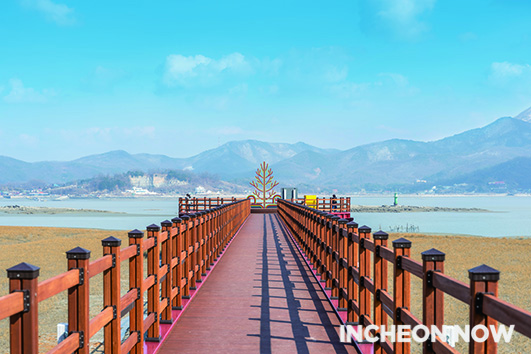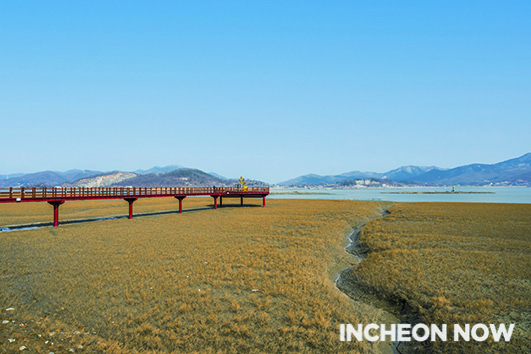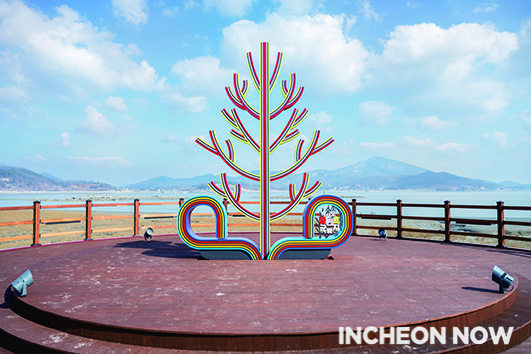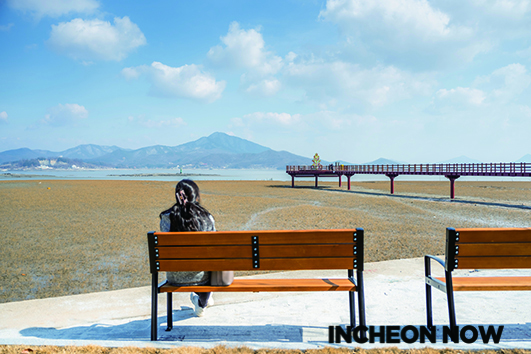[Four Seasons] Spring’s Scenery
Incheon in Photos Quietly Breathing Sea Plain, Mudflat
- Chilmyeoncho Coastal Trail in Seongmodo Island, Ganghwa


When the sea moves far away, it reveals the land under it, a mudflat, a vast treasure trove of life. Incheon’s mudflats account for 29.3% of the total mudflats in Korea, making it the second-largest mudflat region after Jeollanam-do. Incheon’s mudflats boast a large scale and outstanding ecological value. Among them, the Seongmodo mudflat in Ganghwa is famous for its colony of chilmyeoncho (East Asian seepweed), one of the halophytes.
Recently, the Chilmyeoncho Coastal Trail opened in Seongmodo Island of Ganghwa. When you take a slow walk on the wooden walkway, where you can observe the vast ‘mudflat’ and ‘chilmyeoncho (East Asian seepweed)’ more closely, you can enjoy various sceneries of the mudflat. Tidal channels spread across the gray land. A tidal channel is a long and narrow waterway created by seawater flow. It winds and becomes entangled here and there, creating unique patterns all over the mudflat. Myriads of holes on the mudflat are the breathing pores of marine life living there. You can experience the romance of the West Sea in various ways, combining the salty scent of the sea, the cool breeze, and the rich black land. Another charm of the mudflat is the ‘fantastic harmony’ created by the gray mudflats and the chilmyeoncho that has turned deep pink. Chilmyeoncho is green in spring, turns red in fall, and gradually purple. For this, it is also called the maple of the sea. If you want to enjoy this scenery, visit between September and mid-October.


What is Chilmyeoncho?
It has been said that the name chilmyeoncho (seven-face herb) was given because the leaves and stems changed color seven times while changing from light green to red. Another story is that it is because the six-sided fruit has different colors on each side, and the stems and leaves are red.
- Habitat Mudflats by the coast
- Life Form Annual herb
- Size 10-50cm
- Shape The leaves are linear with sharp ends and the plant has many branches at the top.
- Address Seongmodo Island | San 1-2 Maeeum-ri, Samsan-myeon, Ganghwa-gun, Incheonber
고요히 숨 쉬는 바다의 벌판, 갯벌
- 강화 석모도 칠면초 해안길
바다가 저 멀리 떠나면 그 밑 숨겨져 있던 땅이 모습을 드러낸다. 광활한 생명의 보고, 갯벌이다. 인천 갯벌은 국내 갯벌 총면적의 29.3%로 전라남도에 이어 두 번째로 큰 규모다. 인천 갯벌은 넓은 면적과 탁월한 생태적 가치를 자랑한다. 그중에서 강화 석모도 갯벌은 염생식물 중 하나인 칠면초의 군락지로 유명하다.
최근 강화 석모도 칠면초 해안 산책로가 개방됐다. 드넓은 ‘갯벌’과 ‘칠면초’를 더 가깝게 관찰할 수 있는 나무테크로 길을 따라 천천히 걷다 보면 갯벌의 다양한 풍경을 감상할 수 있다. 회색빛 대지에는 갯골이 퍼져 있다. 갯골은 바닷물이 드나들며 형성된 길고 좁은 물길이다. 구불구불 휘어졌으며 이리저리 얽혀 갯벌 곳곳에 독특한 무늬를 그려낸다. 갯벌 위에 자리한 수많은 구멍들은 이곳에 살고 있는 해양생물의 숨구멍이다. 짭조름한 바다향과 시원한 바람, 풍요로운 검은 땅 등이 어우러진 서해의 낭만을 다채로운 모습으로 만날 수 있다.
또 다른 매력은 회색빛 갯벌과 진분홍으로 변한 칠면초가 이루는 ‘환상적인 조화’다. 칠면초는 봄에는 초록빛을 띠다가 가을이 되면서 붉게 물들고 차츰 자주색으로 변한다. 그래서 바다의 단풍이라고도 불린다. 이 풍광을 보고 싶다면 9월부터 10월 중순 사이에 방문하면 된다.
* 칠면초란?
잎과 줄기가 연두색에서 붉은색으로 변화하는 과정에서 7번 색깔을 변해서 이름이 붙여졌다는 이야기가 전해진다. 또 다른 설로는 육면체 모양의 열매가 면마다 빛깔이 다른 데다 줄기와 잎은 붉은색을 띠고 있어 칠면초라고 부른다고 한다.
- 서식지 : 바닷가 갯벌
- 생활형 : 한해살이풀
- 크기 : 10~50㎝
- 모양 : 잎은 선형으로 끝이 뾰쪽하고 퉁퉁하며, 윗부분에서 가지가 많이 갈라진다.